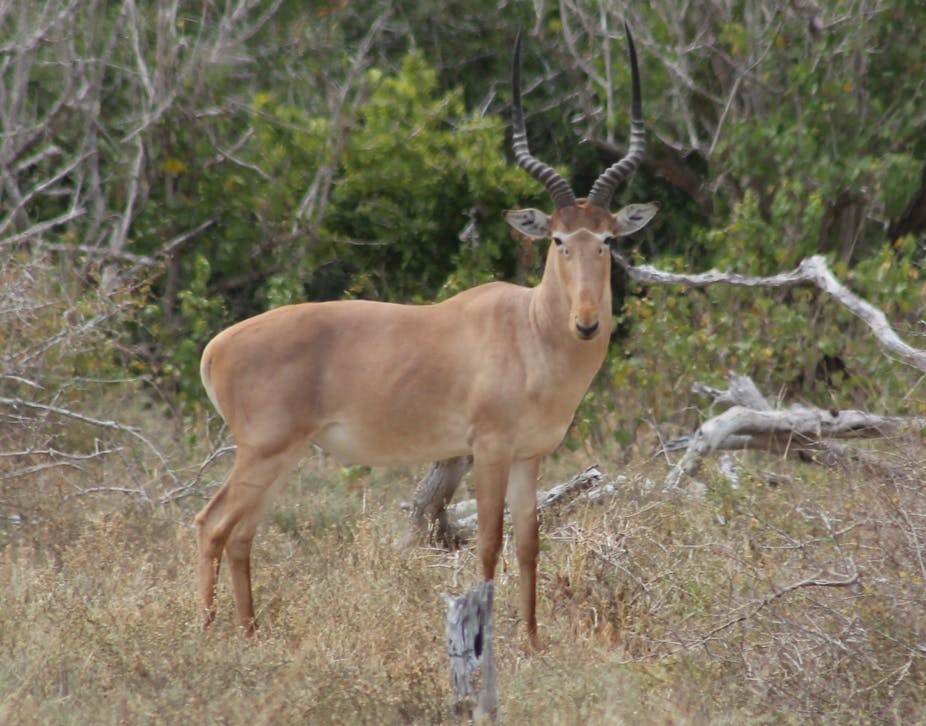The Hirola, endemic to north-east Kenya and south-west Somalia, is the world’s most endangered antelope. It faces huge survival challenges but all is not lost. The Conversation Africa’s Samantha Spooner asked Abdullahi Ali about his research and what he thinks can be done to save this rare species.
What is a hirola, where is it found and how many are there?
The hirola is a rare medium size antelope that can weigh up to 118kg. It’s tawny or tan brown in colour and has long, sharp horns.
The current population of the hirola is estimated at less than 500. This small population is found within its native range, restricted to communal lands along the Kenya-Somalia border with no formal protection. The highest numbers are in Ijara and Garissa County, Kenya.
The hirola is the only surviving member of the genus Beatragus and there are none in captivity.
The hirola is known as the “world’s most endangered antelope”. What factors caused this?
With a global population size of 500, the hirola is considered to be the world’s most endangered antelope. This is the smallest known number of an antelope species and its population has been reducing rapidly since the 1970s.
Several factors caused this. In the 1980s, rinderpest – a viral disease – killed about 85-90% of the existing 15,000 hirola, along with other wildlife. When the disease was eradicated in the early 1990s, the hirola populations didn’t bounce back.
In my recent study, my colleagues and I identified a combination of additional factors that kept their numbers low, and decreasing.
Firstly, hirola are a grassland species. Therefore, overgrazing by both livestock and other wildlife have led to a loss of food for the hirola in its native range.
The loss of elephants from hirola habitat, due to massive poaching, also contributed significantly to the encroachment of trees into grasslands and led to reduced grasses for them to eat. Elephants control forestation as they uproot, break or eat trees. In their absence, trees increase relative to grass cover.
Similarly, there used to be frequent bush fires, which contributed to a balance between tree cover and grassland. These were frequently used by locals but became suppressed by government policy.
Another key factor responsible for their low numbers is predation by carnivores. Lions, cheetahs, wild dogs and leopards pose a significant threat to the already diminishing hirola population. With such a low population, the survival of every individual counts. In many situations predators target mothers and their calves. This is because after calving, the female and her calf will temporarily disassociate from groups making them easier prey.
Finally, several droughts have occurred in the hirola’s range which also led to many deaths.
Why has their conservation and recovery been so difficult?
The conservation and recovery of hirola has been difficult for a variety of reasons.
Language, religious and ethnic differences between conservationists and the Somalis living in Eastern Kenya, have led to suspicion and mistrust. This limits conservation efforts to opportunistic field visits by outsiders rather than a long-term, sustainable project.
Insecurity is also a big problem in parts of eastern Kenya – this includes the hirola’s rangeland. These areas have been volatile since independence due to banditry activities from across the border and conservationists have shied away from these areas.
Another barrier to conservation is the neglect of this region by the government. The area is marginalised and has poor infrastructure which makes it difficult to establish conservation projects or protected areas for the hirola.
A final, major factor is competition for pasture and other resources between the communities in the area, who rely on livestock, and the wildlife. This leads to apathy for conservation and a lack of participation by locals in recovery efforts.
*What can be done to save them? *
Based on my research I believe that the following measures would help save the hirola:
Since there is a link between community livelihoods and hirola habitat, conservation projects must be supported by local communities. Trained, local scientists should be encouraged to take the lead in these. Communities are more likely to embrace conservation as a form of land-use if it’s not led by outsiders.
More protected areas should be created and existing sites need restoration. A part of this includes the restoration of the Arawale National Reserve which is at the centre of the hirola’s geographic range. This is a government protected area in Garissa County that used to thrive but has been neglected since 1982.
Because of the massive tree encroachment in the area that reduced grasslands, I also recommend:
Manual tree removal, to reduce tree encroachment on grassland, and native grass reseeding to increase food for the hirola
Voluntary reduction in livestock numbers to minimise overgrazing and competition between hirola and livestock
Community-based protection of elephants – in the form of anti-poaching squads and enhanced communication between villages – so that elephant herds can be safe on community land
Finally, there’s a big need for sustained funding. Conservation efforts tend to focus on other species in Kenya.

